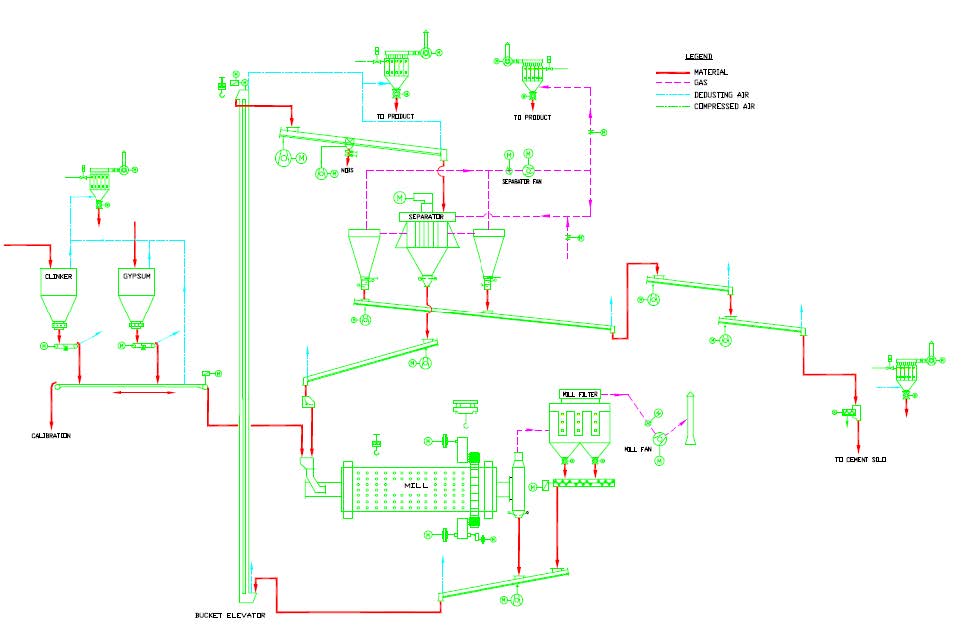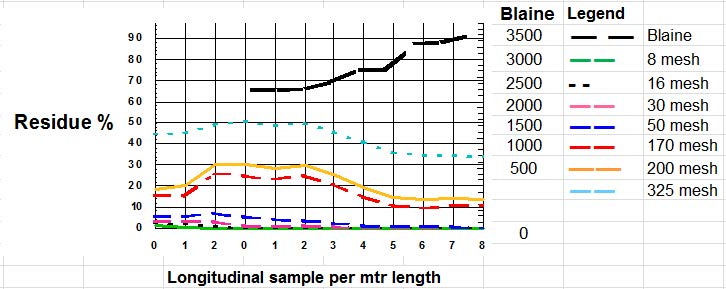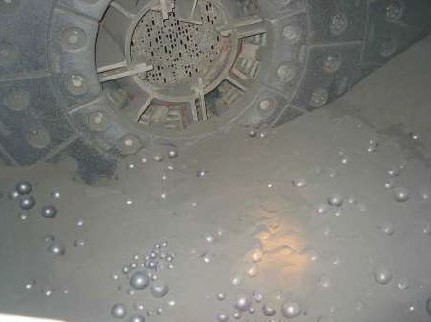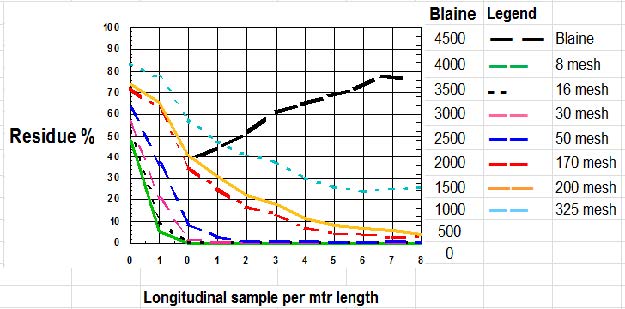Optimization of Cement Grinding Operation in Ball Mills
By Jagrut Upadhyay
Several energy efficient options for cement grinding are available today such as vertical roller mills, roller presses (typically in combination with a ball mill), and clinker pre-grinders with ball mills. Ball mills have been the traditional method of comminution in the mineral processing industries and continue to operate with old generation classifiers, their maintenance sometimes neglected. This in combination with an inefficient operation translates into high energy consumption and low production.
The consumption of energy by the cement grinding operation amounts to one third of the total electrical energy used for the production of cement. The optimization of this process would yield substantial benefits in terms of energy savings and capacity increase.
1. Optimization of the Cement Ball Mill Operation
Optimization addresses the grinding process, maintenance and product quality. The objective is to achieve a more efficient operation and increase the production rate as well as improve the run factor. Consistent quality and maximum output with lower specific power consumption results in lower operating costs per unit of production. Optimization can also reduce the cost of liners and grinding media.
The cost of optimization is minimal since inspecting the mill and the resulting modifications — such as re-grading the grinding media or moving the diaphragm are labor elements that can be handled by the plant’s maintenance crew. Upgrading the classifier and baghouse involves capital expenditure with a high benefit to cost ratio.
Optimization is especially important when multiple products are being produced.
2. Operation and Elements of a Closed-Circuit Ball Mill System
Cement ball mills typically have two grinding chambers. The first chamber is filled with larger diameter grinding media and lined with lifting liners. The first chamber coarse-grinds the feed material and prepares it for the second chamber. The second chamber is the fine grinding chamber. It is lined with classifying-type mill shell liners and provided with finer ball charge. Classifying liners ensure that the ball charge is segregated along the length of the chamber keeping larger grinding media at the beginning of the compartment and smaller media towards the end of the chamber.
An intermediate partition, called the central diaphragm, separates the coarse and fine grinding chambers. The purpose of the central diaphragm is to retain the grinding media in their respective chambers, provide adequate opening for the airflow and, in some special types, regulate the feed to the second compartment.
The mill is equipped with a discharge diaphragm at the end. This diaphragm retains the grinding media in the second chamber and allows the discharge of finely ground material.
Figure 1. Closed Circuit Ball Mill System

Clinker, Gypsum and other desired additives are fed to the ball mill in specific proportions based on the quality requirement. Feed material is ground in the ball mill, discharged and fed to a classifier with the help of a bucket elevator for classification of the ground cement into two streams – coarse and fines. The coarse fraction is sent back to the mill and the fines are collected in cyclones and / or a baghouse as finished product.
The mill is ventilated by an induction fan. The air required for classification is provided by another fan. The fans pull the gases through independent baghouses which clean the vent air and return the cement dust to the system.
3. Auditing Operation
The audit of a closed circuit grinding system focuses on feed material characteristics, grinding progress in the mill, mill ventilation, classification and controls.
Internal inspection of the mill can reveal a lot of important and vital information about the performance of the grinding system such as the separator’s behavior, influence of grinding media and the mill ventilation.
Circuit sample analysis and mill chambers sample analysis indicates performance of the separator and progress of the grinding process along the length of the mill.
The separator is expected to perform in a way that a minimum of the fines is carried in the coarse reject fraction and sent to the mill for regrinding. The separator’s efficiency is determined by drawing a Tromp curve based on particle size distribution analysis. The separator’s performance can be improved by changing the adjustments or replacing worn components. The operational controls are also reviewed for optimized mill operation.
Every element of a closed circuit ball mill system is evaluated independently to assess its influence on the system.
Figure 2 below is a typical example of inefficient grinding indicated by the analysis of longitudinal samples taken after a crash stop of the mill.
Figure 2. Analysis of Longitudinal Samples

The graphical analysis in Figure 2 represents the progress of the grinding process along the length of the mill. In a correct operation the residue will be high initially, falling gradually as grinding progresses, which is not the case in the above graph. Compare this with the milling progress as presented in Figure 4 after optimization.
The following picture shows the condition of the grinding media and the material in one of the grinding chambers of the mill. These observations provide a clear idea of internal conditions — such as a clogged diaphragm or incorrect material level — and present the potential steps for optimization.
Figure 3. Condition in one of the Grinding Chambers of the Mill

4. Results of Optimization
The graphical analysis presented in Figure 4 represents progress of grinding along the length of the mill after optimizing the grinding process. Desired progress of grinding is clearly visible in the graphs.
Figure 4. Analysis of Longitudinal Samples

Use of suitable grinding aids also is recommended to improve grinding. However, it is important to mention that grinding aids should not be considered as optimization tools. It is recommended that all operational and process deficiencies be eliminated and that the system be optimized before considering use of a grinding aid to further improve the process.
Results of the optimization can be measured by multiple parameters such as separator efficiency, specific power consumption, system throughput, and wear rate of grinding media and liners.
Changing the separator to a high efficiency type brings about better residue value (on 45 micron) for the same Blaine. Alternatively, the cement can be ground to a lower Blaine with the same residue, which determines the strength of cement. In most cases the layout permits replacing the separator to a high efficiency type.
An evaluation of the grinding system and operation includes meaningful and critical inspection of all equipment, components and the process parameters by experts.
PEC Consulting can help carry out detailed evaluation of existing grinding systems and their operation and recommend steps for improving performance.
About the Author(s)
Jagrut Upadhyay
Mr. Upadhyay has 30 years of experience in the cement industry. He is an expert process engineer whose core competence lies in the optimization of cement plant operations. He has been responsible for plant upgrades and the implementation of cost-saving measures. He has played an important role as a team leader in the areas of Process Engineering, Plant Operation & Maintenance, Production, Distribution, Plant Commissioning, and Environmental Compliance. He has been involved in projects relative to the evaluation of fuels for use in cement kilns and energy efficiency programs. He holds a Bachelor of Science in Chemical Engineering, D.D. Institute of Technology, Gujarat University, India.
PEC Consulting Group LLC | PENTA Engineering Corporation | St. Louis, Missouri, USA
How can we help you? Get in touch with our team of experts.
